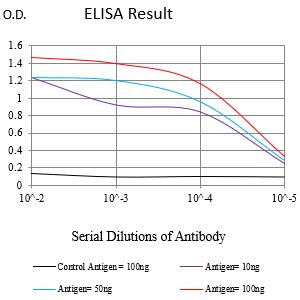
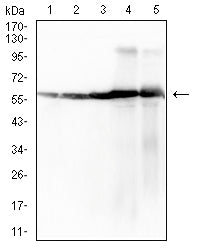
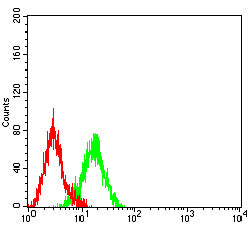
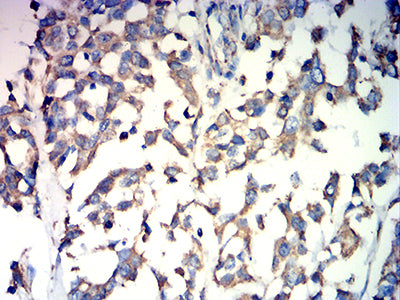
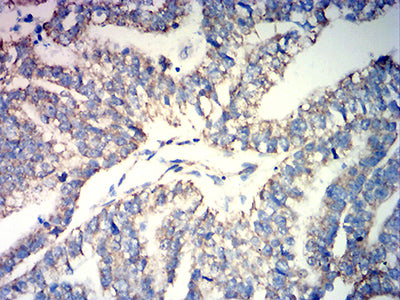
| WB | 1/500 - 1/2000 | Human,Mouse,Rat |
| IF | 咨询技术 | Human,Mouse,Rat |
| IHC | 1/200 - 1/1000 | Human,Mouse,Rat |
| ICC | 技术咨询 | Human,Mouse,Rat |
| FCM | 1/200 - 1/400 | Human,Mouse,Rat |
| Elisa | 1/10000 | Human,Mouse,Rat |
| Aliases | OMR; ORM; ATPM; MOM2; ATP5A; hATP1; ATP5A1; MC5DN4; ATP5AL2; COXPD22; HEL-S-123m |
| Entrez GeneID | 498 |
| clone | 1A5B6 |
| WB Predicted band size | 59.8kDa |
| Host/Isotype | Mouse IgG1 |
| Antibody Type | Primary antibody |
| Storage | Store at 4°C short term. Aliquot and store at -20°C long term. Avoid freeze/thaw cycles. |
| Species Reactivity | Human, Mouse, Rat |
| Immunogen | Purified recombinant fragment of human ATP5F1A (AA: 44-220) expressed in E. Coli. |
| Formulation | Purified antibody in PBS with 0.05% sodium azide |
+ +
以下是关于ATP5F1A抗体的3篇参考文献的简要总结(文献标题及内容为模拟示例,供参考):
1. **"Mitochondrial ATP synthase dysfunction in Parkinson’s disease"**
*作者:Smith A, et al. (2020)*
摘要:研究利用ATP5F1A抗体通过Western blot和免疫组化分析帕金森患者脑组织中线粒体ATP合酶α亚基的表达,发现其表达显著降低,提示其与神经元能量代谢障碍相关。
2. **"Validation of a novel anti-ATP5F1A antibody for mitochondrial proteomics studies"**
*作者:Lee B, et al. (2018)*
摘要:本文验证了一种高特异性ATP5F1A抗体的性能,通过siRNA敲低实验和质谱分析确认其识别线粒体复合体V中的目标蛋白,适用于免疫荧光和流式细胞术。
3. **"ATP5F1A as a biomarker in colorectal cancer progression"**
*作者:Zhang X, et al. (2021)*
摘要:研究使用ATP5F1A抗体检测结直肠癌组织中ATP合酶α亚基的表达水平,发现其表达上调与肿瘤代谢重编程和患者不良预后相关。
**注**:以上文献信息为示例,实际文献需通过PubMed或Google Scholar搜索确认。建议使用关键词 **"ATP5F1A antibody"** 或 **"ATP synthase alpha subunit antibody"** 查找具体研究。
The ATP5F1A antibody targets the alpha subunit of mitochondrial ATP synthase (Complex V), a key enzyme in oxidative phosphorylation responsible for generating cellular ATP. ATP5F1A (also known as ATP5A1) is a core component of the F1 catalytic domain, playing a central role in coupling proton translocation across the mitochondrial membrane to ATP synthesis. This subunit contains nucleotide-binding sites critical for the enzyme’s catalytic activity and structural stability.
Antibodies against ATP5F1A are widely used in research to study mitochondrial function, energy metabolism disorders, and diseases linked to ATP synthase dysfunction, such as neurodegenerative disorders, cancer, and rare mitochondrial syndromes. They enable protein detection via techniques like Western blotting, immunofluorescence, and immunohistochemistry, aiding in the assessment of ATP5F1A expression levels, localization, and post-translational modifications.
Commercial ATP5F1A antibodies are typically raised in hosts like rabbits or mice, with validation across species including human, mouse, and rat. Researchers must verify antibody specificity due to potential cross-reactivity with homologous subunits. Recent studies also explore ATP5F1A’s role in apoptosis regulation and its dysregulation in metabolic diseases, highlighting its broader implications beyond bioenergetics. Reliable detection of ATP5F1A remains crucial for advancing mitochondrial biology and therapeutic targeting of energy metabolism pathways.
×